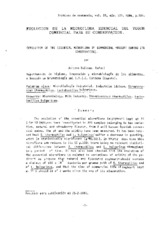Mostrar el registro sencillo del ítem
Evolución de la microflora esencial del yogur comercial para su conservación
| dc.contributor.author | Jordano-Salinas, R. | |
| dc.date.accessioned | 2010-05-06T09:42:18Z | |
| dc.date.available | 2010-05-06T09:42:18Z | |
| dc.date.issued | 1984 | |
| dc.identifier.issn | 1885-4494 | |
| dc.identifier.uri | http://hdl.handle.net/10396/3174 | |
| dc.description.abstract | The evolution of the essential microflora in yoghourt kept at 72 C for 40 days,has been investigated in 300 samples belonging to two varieties, natural and strawberry flavour, from 3 well-kanown Spanish commercial makes. The pH and the acidity have been measured. It has been noticed that S. thermophilus and L. bulgaricus suffer a decrease in quantity, which is statistically significant (p 1O.OO1). In thirty days time this microflora was reduced to its 50 p.100; there being no relevant statistical differences between S. thermophilus and L. bulgaricus throughout this period of time. It has also been checked that the evolution of the essential microflora is related to variations of acidity of the yoghourt We propose th%t natural and flavoured yoghourts should contain a minimum of 100 x 10 bacteria per gramme both of S. thermophilus and of L. bulgaricus, and that the time of commercial life of yoghoyr"t kept at 72 C should be of 3 weeks since the end of its elaboration. | en |
| dc.description.abstract | Se ha investigado la evolución de la microflora esencial del yogur conservado durante cuarenta días a 72 C, en 300 muestras de dos variedades elaboradas en España (natural y sabor a fresa) pertenecientes a tres marcas de gran difusi6n comercial. Se ha medido también el pH y la acidez titulable. Se ha comprobado que el S. thermophilus y el L. bulgaricus experimentan un descenso numérico que es estadísticamente significativo (p0,001). A los treinta días de conservación esta microflora se había reducido en un porcentaje próximo al cincuenta por ciento y no existían diferencias significativas entre el S. thermophilus y el L. bulgaricus. Igualmente, se ha constatado que la evolución de la microflora esencial esta relacionada con las variaciones de la acidez titulable. Como consecuencia de la investigación se propone para el yogur, naturad l y aromatizado, que dichos productos contengan un mínimo de 100 x 10bacterias esenciales por gramo., tanto de S. thermophilus como de L. bulgaris, y se estima que la vida comercial del yogur conservado a 72 C es de tres semanas, contabilizadas a partir del termino de su elaboración. | es_ES |
| dc.format.mimetype | application/pdf | es_ES |
| dc.language.iso | spa | es_ES |
| dc.publisher | Universidad de Córdoba, Servicio de Publicaciones | es_ES |
| dc.rights | https://creativecommons.org/licenses/by-nc-nd/4.0/ | es_ES |
| dc.source | Archivos de zootecnia 33 (127), 237-248 (1984) | es_ES |
| dc.subject | Streptococcus thermophilus | es_ES |
| dc.subject | Lactobacillus bulgaricus | es_ES |
| dc.subject | Microbiología | es_ES |
| dc.subject | Industrias lácteas | es_ES |
| dc.title | Evolución de la microflora esencial del yogur comercial para su conservación | es_ES |
| dc.title.alternative | Evolution of the essential microflora of commercial yogourt during its conservation | en |
| dc.type | info:eu-repo/semantics/article | es_ES |
| dc.relation.publisherversion | http://www.uco.es/organiza/servicios/publica/az/az.htm | es_ES |
| dc.rights.accessRights | info:eu-repo/semantics/openAccess | es_ES |

